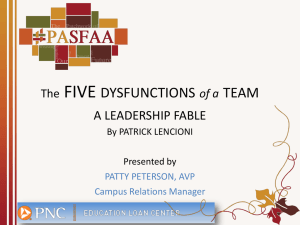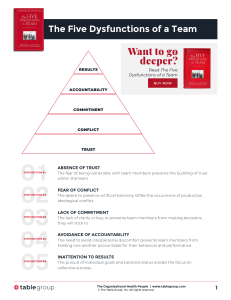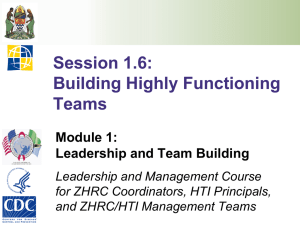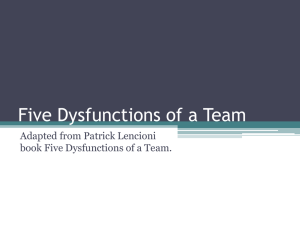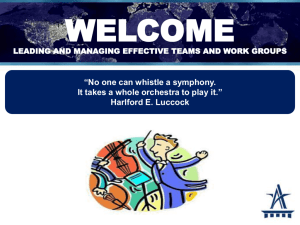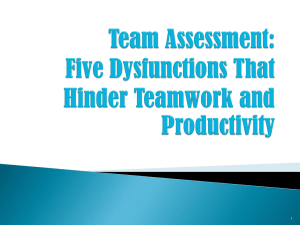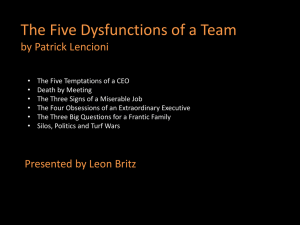The Five Dysfunctions of a Team
advertisement
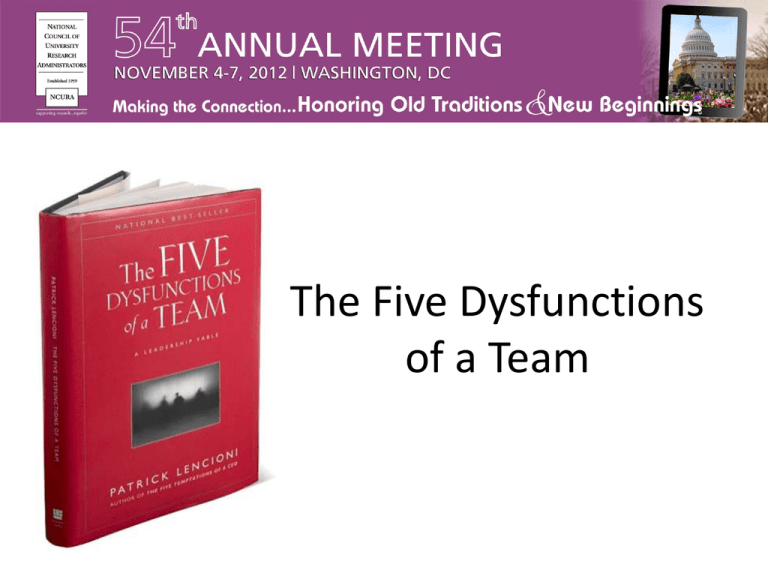
The Five Dysfunctions of a Team A Leadership Fable The Five Dysfunctions of a Team The Five Dysfunctions of a Team The Five Dysfunctions of a Team What’s this mean to Sponsored Research? Performance “If you could get all the people in an organization rowing in the same direction, you could dominate any industry, in any market, against any competition, at any time.” Lencioni, Patrick, “The five dysfunctions of a team”, John Wiley & Sons - 2002 Team Alignment Finding good players is easy. Getting them to play as a team is another story. - Casey Stengel True Team The true measure of a team is that it accomplishes the results that it sets out to achieve. 5 Dysfunctions Inattention to Results Avoidance of Accountability Lack of Commitment Fear of Conflict Absence of Trust Absence of Trust Trust is all about vulnerability. Video One: Absence of Trust • Jenny is a sponsored programs specialist in the Office of Sponsored Programs for a large public research university who is facing an impending deadline … Dysfunction #I: “Remember teamwork begins by building trust. And the only way to do that is to overcome our need for invulnerability.” ― Patrick Lencioni, The Five Dysfunctions of a Team: A Leadership Fable Dysfunction #I: • Absence of Trust: Members of great teams trust one another on a fundamental, emotional level, and they are comfortable being vulnerable with each other about their weaknesses, mistakes, fears, and behaviors. Dysfunction #I: • They must get to a point where they can be completely open with one another, without filters. Dysfunction #I: • The key to overcoming a lack of trust is shared experiences, multiple follow – through and integrity. Dysfunction #I: Role of the leader • The primary role of the leader is to lead my example, be the first one to be vulnerable, and create an environment where it’s safe to be vulnerable. • Building trust makes conflict possible! Video Two: Fear of Conflict • OSP as a political and unpleasant place to work • Daniel is the leader of a team of federal grant accountants in the OSP office of an academic medical center. Daniel’s weekly team meetings are a low-point on everyone’s calendar for good reason … Dysfunction #2: • Fear of Conflict:... teams that trust one another are not afraid to engage in passionate dialogue around issues and decisions that are key to the organization's success. Dysfunction #2: • Trust is the foundation of great teams and it’s trust that makes team conflict possible. • “Harmony itself is good, I suppose, if it comes as a result of working through issues constantly and cycling through conflict. But if it comes only as a result of people holding back their opinions and honest concerns, then it’s a bad thing.” Dysfunction #2: • We wear masks and focus on being nice to everyone. however, productive conflict is required for teams to become functional. This allows for meaningful dialogue where people are open to share, without feeling fearful of reprisal or criticism. One of the worst team dysfunctions is when you have a team of “yes men”. Dysfunction #2: • On one end, there is artificial harmony with no conflict at all, and on the other there are mean-spirited, personal attacks. In the exact middle of that continuum there is a line where conflict goes from constructive to destructive or vice versa, depending on which direction you're going. Dysfunction #2: Role of the leader • Mine For Conflict • Conflict Profiling • Someone's conflict profile is determined by – Temperament & Personality – Cultural background and family norms • Great teams don’t hold back their opinions. – But team members must understand one another's conflict profiles. Video Three: Lack of Commitment • Implementation of something as large as a new University policy requires commitment from the whole university Dysfunction #3: • Lack of Commitment ... teams that engage in unfiltered conflict are able to achieve genuine buy-in around important decisions, even when various members of the team initially disagree. That's because they ensure that all opinions and ideas are put on the table and considered, giving confidence to team members that no stone has been left unturned. Dysfunction #3: • When teams engage in productive conflict they can confidently commit and buy-in to decisions. Commitment is a function of clarity and buy-in. Productive teams make clear decisions and are confident that they have the support from every team member. A lack of commitment usually arises from not hearing all the teams concerns before making a decision. • At the end of the day everyone needs to get to the point where they can say, “I may not agree with your ideas but I understand them and can support them.” Dysfunction #3: Role of the leader • Force Clarity and Closure • “The point here is that most reasonable people don’t have to get their way in a discussion. They just need to be heard, and to know that their input was considered and responded to.” • “When people don’t unload their opinions and feel like they’ve been listened to, they won’t really get on board.” Video Four: Avoidance of Accountability • Accountability is an overused word in today’s culture and as a result it has lost much of its meaning. Brian is a department administration in a midsized land-grant university who is getting a different answer from each person he talks to in the OSP Dysfunction #4: • Avoidance of Accountability:... teams that commit to decisions and standards of performance do not hesitate to hold one another accountable for adhering to those decisions and standards. What is more, they don't rely on the team leader as the primary source of accountability, they go directly to their peers. Dysfunction #4: • Without team commitment you cannot have accountability. If the team is to be accountable, everyone must have a clear understanding of what is expected of them. • “People aren’t going to hold each other accountable if they haven’t clearly bought in to the same plan.” Dysfunction #4: Role of the leader • Confront Difficult Issues • It’s important to make clear what the team’s standards are, what needs to get done, by who and by when. Ambiguity is the enemy of accountability. Video Five: Inattention to Results • Who is your First Team? • How to put your OSP team and Institute First • Being help accountable to Goals • The story of how she got fired from a previous job because she promoted an employee who everyone hated, like Mikey, when she probably should have fired him because his negative behavior was bringing down the performance of the entire department. • Don is the director of the OSP of a mid-sized academic medical center plagued with financial concerns and the impending sequestration. Dysfunction #5: • Inattention to Results: ... teams that trust one another, engage in conflict, commit to decisions, and hold one another accountable are very likely to set aside their individual needs and agendas and focus almost exclusively on what is best for the team. Dysfunction #5: Role of the leader Focus on Collective Outcomes “Our job is to make the results that we need to achieve so clear to everyone in this room that no one would even consider doing something purely to enhance his or her individual status or ego. Because that would diminish our ability to achieve our collective goals. We would all lose.” Page Role of the Leader Inattention to Results Focus on Collective Outcomes Avoidance of Accountability Confront Difficult Issues Lack of Commitment Force Clarity and Closure Fear of Conflict Mine For Conflict Absence of Trust Go First Cohesive Teams “…and imagine how members of truly cohesive teams behave: • 1. They trust one another. 2. They engage in unfiltered conflict around ideas. 3. They commit to decisions and plans of action. 4. They hold one another accountable for delivering against those plans 5. They focus on the achievement of collective results.” Questions you need to ask… #1: Are we really a team? #2: Are we ready for heavy lifting? Conclusion • Over the course of the next year our team implemented decision and review roles and responsibilities and collective goals. • The Five Dysfunctions Model can be viewed in a more positive way by thinking of what good teams do instead of what hurts teams. Good teams trust each other, engage in constructive ideological conflict and do not hold back, commit to the decisions and plans they make, hold each other accountable for working to make plans happen, and they are focused on collective results. • Patrick Lencioni. Overcoming the Five Dysfunctions of a Team: A Field Guide for Leaders, Managers, and Facilitators (J-B Lencioni Series) (Kindle Locations 55-56). Kindle Edition.
